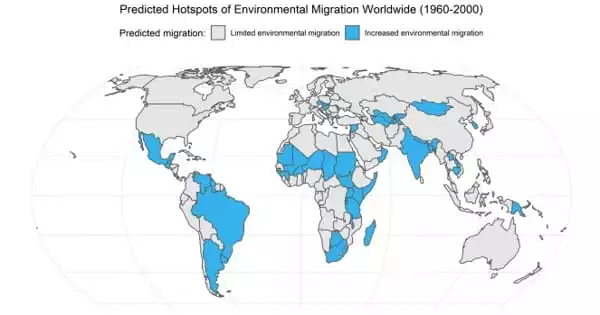Climate-driven migration has been identified as a serious danger in public debate and academic study, but comprehensive studies that consider both environmental and socioeconomic aspects on a worldwide scale are lacking. A study team has now developed a clearer picture of the dynamics involved in migration for 178 nations using machine learning.
The world is focused on the ramifications of a climate crisis and how we might yet reverse course with the United Nations climate conference in Glasgow. Despite the fact that climate-driven migration has been identified as a serious problem in public debate and academic study, comprehensive studies that consider both environmental and social factors on a global scale are rare. A research team lead by Aalto University has now developed a clearer picture of the elements involved in migration for 178 nations using machine learning.
Traditionally, climate change-related migration research has taken a linear approach, focusing on whether or not environmental stress is directly related to migration – often for one nation or group of countries at a time. Researchers have known that social factors must have a role, but investigating both on a global scale, with all necessary data for all countries and sub-regions, has been a significant difficulty.
Perhaps the most surprise finding from our analysis is that, when we look at the big picture, social variables are more important than environmental factors in explaining migration.’ And, independent of income level, gross national income was the primary factor in explaining net migration in half of the nations.
Venla Niva
‘Perhaps the most surprise finding from our analysis is that, when we look at the big picture, social variables are more important than environmental factors in explaining migration.’ And, independent of income level, gross national income was the primary factor in explaining net migration in half of the nations,’ says Venla Niva, a doctoral student at Aalto University and lead author of the study published in Environmental Research Letters.
The scientists used a machine learning technique called random forest analysis in their analysis, which is well adapted to dealing with the complicated correlations seen between variables in very large amounts of data. This enabled the researchers to explain the significance of each component for each of the countries examined. Social determinants included income, years of schooling, life expectancy, and government effectiveness; environmental ones included natural hazards, water risk, food production scarcity, and drought prevalence.
In Finland and Ethiopia, for example, wealth was the most important factor, whereas in the United States and South Africa, education explained the majority of within-country variation in net-negative migration. In regions where in-migration exceeded out-migration, such as the United States and Ethiopia, health was the most important component, but in Finland and South Africa, money was the trait that best predicted net-positive migration. Drought risk was the most important environmental variable on a global scale. Drought risk and water risk were two of the top three environmental variables in Ethiopia in terms of net-positive migration.

The data used in the analysis ranges from 1990 to 2000, which is the most recent period for which information from 178 countries, including high- and low-income, is accessible at the level of detail studied: 10 km x 10 km units
‘Very precise data at the local, rather than national, level allows us to see the places from which people have relocated, as well as the areas to which they have gone – whether across borders or within the country. For example, if a given location has experienced environmental hardship, such as drought, we can zoom in to determine if there has been a loss of individuals due to out-migration within the same time period,’ adds Niva.
Majority of net-migration occurred in vulnerable regions
The same degree of information indicated that, while environmental factors alone are unlikely to promote migration, environmental pressures in departure nations or areas are important. More than half (58%) of net-negative migration occurred in places with severe environmental stress and little adaptability to change.
‘This is one of our times’ most pressing challenges: places under environmental stress have the lowest resilience, which means they aren’t well suited to deal with changes. As populations in Africa and South Asia grow rapidly, decision-makers must help build capacity to ensure vulnerable places can deal with the implications of a warming climate as well as other environmental stressors,’ says Matti Kummu, professor of global water and food issues at Aalto University.
The team is currently constructing a dataset that spans 2000-2020 to gain a clearer idea of how the factors explain more recent worldwide migration, with results likely in the next year or so.
‘For the time being, we can state that with this just-published study, we’ve been able to identify the basic components involved in migration; next, we’ll investigate whether and how the factors’ importance has altered over time, as the climate warms,’ adds Kummu.
















